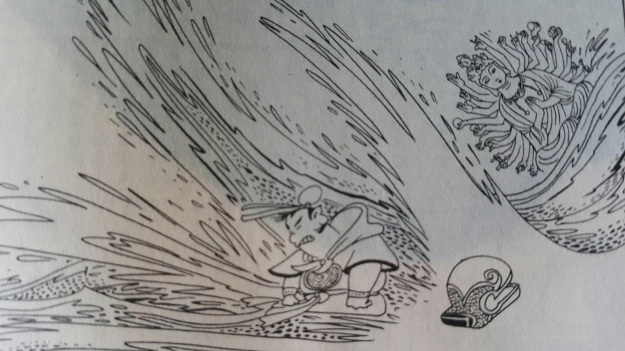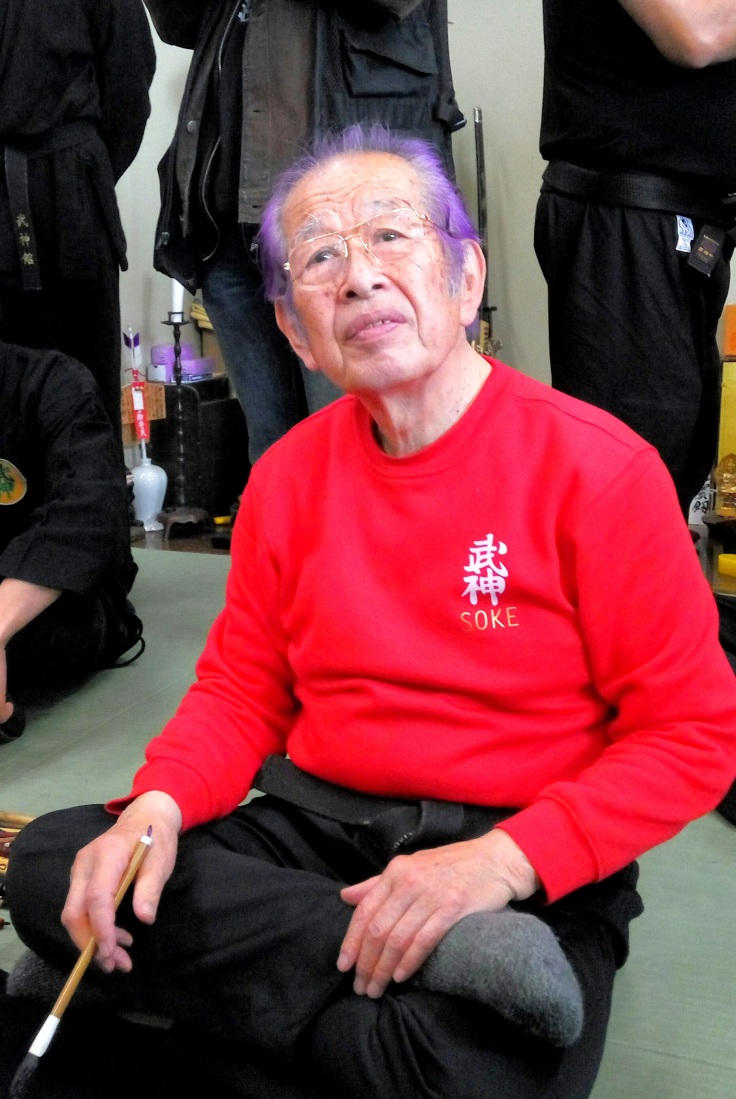From Shiro Kuma's Blog by kumafr
Koto Ryû is Yoko Aruki, in the same way Gyokko ryû is Jûji Aruki. (1)
Each fighting system of the Bujinkan has its particular details. In these two systems, because of the initial distance, the way to cross your legs while fighting, is logical. But this logic has to be enforced in your habits. And, believe me, is not that easy to get it right. (2)
We did some Koto Ryû taijutsu with Noguchi sensei, and I had a hard time crossing my legs correctly on each movement. I am more a Gyokko man.
I got it right only when I began to train more slowly and kept my feet facing the same direction. Slow speed in the acquisition process, is very important to get this footwork motion right.
As often in the Bujinkan, this is not the upper part of the body that matters, but the legs. You know that Bujinkan is about aruki. It couldn’t be more accurate than during this class.
Last Friday, Hatsumi sensei spoke about the difference between the levels of omote waza and ura waza. His point, was that omote is physical, and is mental. But depending on the fighting system you train in, and of your technical level, there are other interpretations.
Omote waza / arms, upper body – ura waza / legs, lower body
Omote waza / simple – ura waza / complex
Omote waza / standard teaching – ura waza / secret teaching
Omote waza / beginner level – ura waza / advanced level
Omote waza / obvious – ura waza / complex
Omote waza / hands – ura waza / feet
On Sunday, Noguchi sensei’s movements were refreshing, and the lines of his legs defined a very nice Koto ryû space. The straight footwork of the Koto ryû have the correct distancing m and he could get his partner off balance without any strength.
At one point, he insisted on going beyond the form, destructuring the original waza, in order to adapt it to uke’s reactions. It was a nice warm up that made sense when the class with Sōke began right after his.
When in Japan, do not focus on the way Sensei and the Shihan unfold the techniques. Whatever they do, it will never be exactly what the original text say. Instead, try to “read between the lines” and learn how to “read” their movements. This is the best way to improve your taijutsu. Obviously, it requires that you already know quite well the waza of every fighting system of the Bujinkan.
Free flow comes from good basics. How do you want to adjust a movement if you don’t know it in the first place? Is impossible. Learn the waza, train the waza, then go to Japan and learn the flow of natural movement. This is why you train ride basics in your dōjō. The tenchijin leads to the ryûha (taijutsu and Buki). Ryûha lead to the honbu. There’s no shortcut. Excellence is based on the correct training in the fundamentals.
Often I hear practitioners complaining that classes are not for beginners. Maybe that is why Sensei keeps repeating that he is teaching for Jūgodan.
Understand me well. It is ok for beginners to come and train in Japan, but it will not be easy. At least they will have good memories.
Beginners should come for the omote waza, advanced practitioners for the ura waza.
________________________
1. Reminder to beginners: Yoko aruki and Jûji aruki are two different ways of cruising the legs. Toes and feet facing the same direction = Koto ryû ; toes and feet perpendicular = Gyokko ryû.
2. Koto ryû having an initial distance of 2m, the movements are more aligned than in the short distance Gyokko, where twisting the body up and down is more logical (distance 60cm)


 This reminds me of a zen parable about a great wrestler named OoNami (Big Wave) He was of great build unstoppable in practice, throwing all opponents with ease. Even his teachers could not keep up with him during training, such was his ability and stunning techniques. But before every match, without fail, he would get so nervous and cowardly that he could barely stand and he would lose every competition. He would even lose to his students. He was fractured, not moving as one, he was disconnected. Just a bunch of moving parts, not crystallized as one. He was so frustrated that he went to a Zen master for help. The Zen master told him, “if your name is big wave, don’t think of yourself as a cowardly wrestler. But imagine yourself to be a great huge wave! A tsunami that engulfs and washes away all in your path! If you can see that, you will become instantly the number one wrestler in the country. You will beatable!”. In the temple that evening, he tried hard to envision himself a wave but his thoughts were disturbing him. Then slowly he started to feel the wave growing in him. As it grew later in the evening, the wave grew too, washing away the flower vases around him. The wave grew stronger still and washed away the statues of the deities in temple. And yet it grew bigger, washing away the temple and finally it engulfed the whole grounds of the temple washing everything away. At that moment, the master spoke, “You have done it! You will be unstoppable like this wave now.”. From that day on he moved as the ocean, with the force and power of great waves, like a tsunami. He became the number one wrestler in the land, sweeping away his opponents with ease. He became the tsunami. He became integrated and whole, each cell and fiber moving as one. Hatsumi Sensei would often tell us to become like a tsunami. A series of unconnected attacks or techniques will not defeat an opponent. But a connect whole, a flow, a wave like a tsunami will fell the toughest opponent. Zen Tai, whole essence, whole body, imagine you are the tsunami, and flow with natural power and rhythm!
This reminds me of a zen parable about a great wrestler named OoNami (Big Wave) He was of great build unstoppable in practice, throwing all opponents with ease. Even his teachers could not keep up with him during training, such was his ability and stunning techniques. But before every match, without fail, he would get so nervous and cowardly that he could barely stand and he would lose every competition. He would even lose to his students. He was fractured, not moving as one, he was disconnected. Just a bunch of moving parts, not crystallized as one. He was so frustrated that he went to a Zen master for help. The Zen master told him, “if your name is big wave, don’t think of yourself as a cowardly wrestler. But imagine yourself to be a great huge wave! A tsunami that engulfs and washes away all in your path! If you can see that, you will become instantly the number one wrestler in the country. You will beatable!”. In the temple that evening, he tried hard to envision himself a wave but his thoughts were disturbing him. Then slowly he started to feel the wave growing in him. As it grew later in the evening, the wave grew too, washing away the flower vases around him. The wave grew stronger still and washed away the statues of the deities in temple. And yet it grew bigger, washing away the temple and finally it engulfed the whole grounds of the temple washing everything away. At that moment, the master spoke, “You have done it! You will be unstoppable like this wave now.”. From that day on he moved as the ocean, with the force and power of great waves, like a tsunami. He became the number one wrestler in the land, sweeping away his opponents with ease. He became the tsunami. He became integrated and whole, each cell and fiber moving as one. Hatsumi Sensei would often tell us to become like a tsunami. A series of unconnected attacks or techniques will not defeat an opponent. But a connect whole, a flow, a wave like a tsunami will fell the toughest opponent. Zen Tai, whole essence, whole body, imagine you are the tsunami, and flow with natural power and rhythm!
